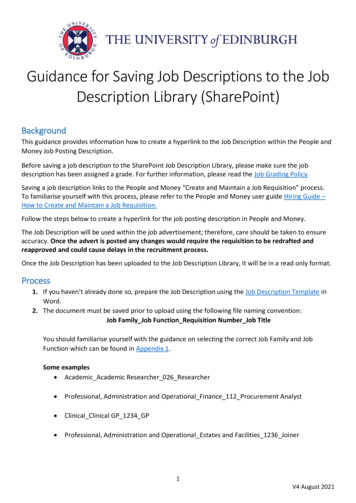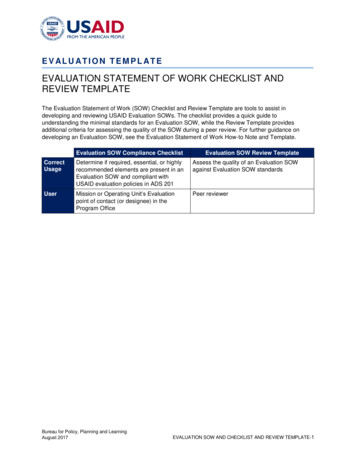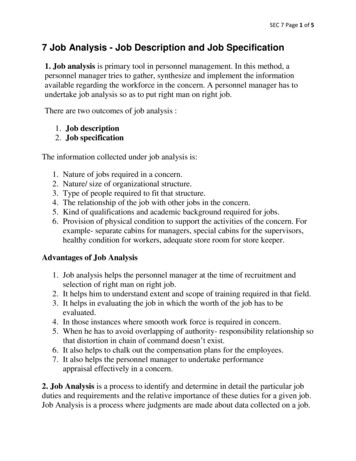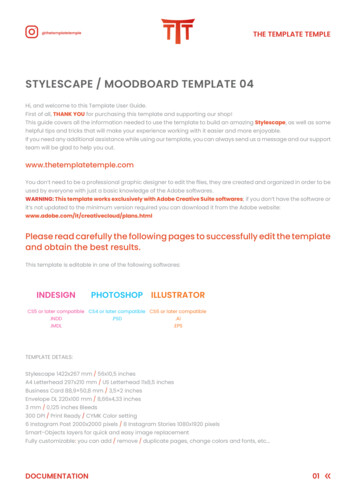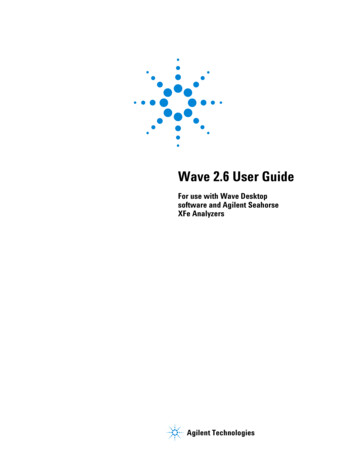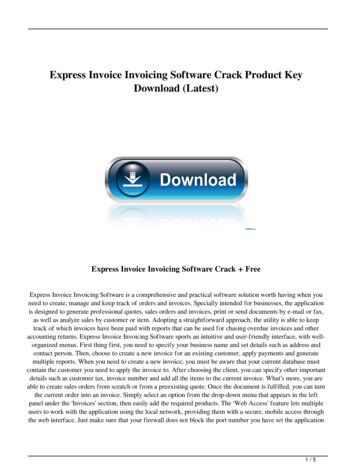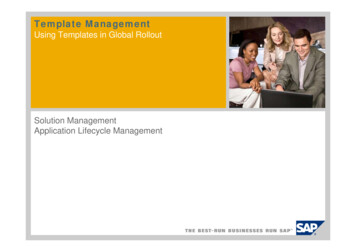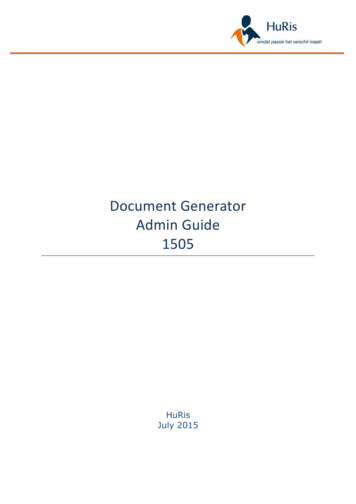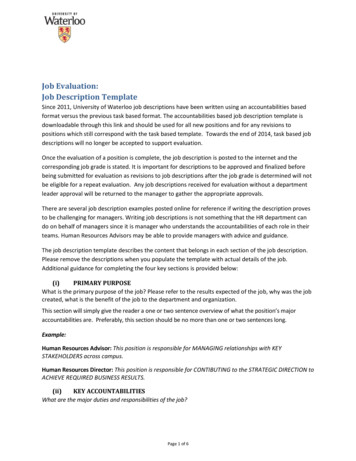
Transcription
Job Evaluation:Job Description TemplateSince 2011, University of Waterloo job descriptions have been written using an accountabilities basedformat versus the previous task based format. The accountabilities based job description template isdownloadable through this link and should be used for all new positions and for any revisions topositions which still correspond with the task based template. Towards the end of 2014, task based jobdescriptions will no longer be accepted to support evaluation.Once the evaluation of a position is complete, the job description is posted to the internet and thecorresponding job grade is stated. It is important for descriptions to be approved and finalized beforebeing submitted for evaluation as revisions to job descriptions after the job grade is determined will notbe eligible for a repeat evaluation. Any job descriptions received for evaluation without a departmentleader approval will be returned to the manager to gather the appropriate approvals.There are several job description examples posted online for reference if writing the description provesto be challenging for managers. Writing job descriptions is not something that the HR department cando on behalf of managers since it is manager who understands the accountabilities of each role in theirteams. Human Resources Advisors may be able to provide managers with advice and guidance.The job description template describes the content that belongs in each section of the job description.Please remove the descriptions when you populate the template with actual details of the job.Additional guidance for completing the four key sections is provided below:(i)PRIMARY PURPOSEWhat is the primary purpose of the job? Please refer to the results expected of the job, why was the jobcreated, what is the benefit of the job to the department and organization.This section will simply give the reader a one or two sentence overview of what the position’s majoraccountabilities are. Preferably, this section should be no more than one or two sentences long.Example:Human Resources Advisor: This position is responsible for MANAGING relationships with KEYSTAKEHOLDERS across campus.Human Resources Director: This position is responsible for CONTIBUTING to the STRATEGIC DIRECTION toACHIEVE REQUIRED BUSINESS RESULTS.(ii)KEY ACCOUNTABILITIESWhat are the major duties and responsibilities of the job?Page 1 of 6
You can divide the major duties in a job into 4 to 5 major categories and these broad categories shouldreflect at least 80-90% of the job (e.g. client service, technical, operations, market development,management of people). Cover the “what” of the job, not the “how”.Explain what the job does, not which tools it uses to do the job, not who the person needs to talk to inorder to perform the task.Describe a typical work day. What are the specific responsibilities and what are the key measures ofsuccess?Watch out when using the words “responsible” or “accountable” – there are only a few jobs in theorganization that can be ultimately accountable for a major aspect within a group. Lower level positionsmay be responsible for a process within the overall accountability, or may be responsible for an individualtask within the major task. Use key verbs to best describe what the position does.For all positions that are responsible for the management of people, the following wording or somethingsimilar should be a key accountability.Ensures the effective utilization, deployment and development of people and capital resources: Deploys staff to productively meet department goals and objectives.Coaches, trains and develops employees in unit name to assure growth and development ofthose individuals for the role, department and University.Conducts Annual Performance Plans with direct reports, and ensures adherence to AnnualPerformance Planning and Review process within the department.(iii)POSITION REQUIREMENTSIf you were hiring today, what would be the minimum qualifications required for the job?Think about the formal/technical schooling, education level, technical skills required (e.g. job specifictraining, computer skills), what specific type of experience is required (e.g. licence or certificates required).Differentiate between education and experience. For example, to be a high-level administrative supportperson, the education requirement may not be high, but the experience required would be very high.(iv)NATURE AND SCOPEThere are five components to this section and a sixth of “Other” should be used if there are any other keydetails that have not been captured (e.g. work that is performed annually, per term or otherwiseinfrequently).a. Interpersonal SkillsWho are the typical internal/external contacts for the job? What is the reason for the contact withothers (see list below.) Some jobs will only have internal contact and some jobs will have both.Internal Contacts may include (within organization): Subordinates, Co-Workers, Supervisor/Manager, OtherStaff.Page 2 of 6
Main reasons for INTERNAL contact may include: (Choose one) Ask clarifying questionsReceive instructions/communicate acceptanceExchange or provide simple informationObtain, clarify, and discuss informationPresent, discuss information and problemsCollaborate, negotiate and “sell” ideasObtain action, reach agreement and negotiateDeal with, influence or motivate employee(s) or group(s) of people (usually internal)Deal with, influence, motivate customers or suppliers (usually external)Promote, justify or settle highly sensitive mattersExternal Contacts may include (outside company): Professional Contacts, Suppliers, Customers, Visitors,General Public, etc.Main reasons for EXTERNAL contact may include (Choose one) Ask clarifying questionsReceive instructions/communicate acceptanceExchange or provide simple informationObtain, clarify, and discuss informationPresent, discuss information and problemsCollaborate, negotiate and “sell” ideasObtain action, reach agreement and negotiateDeal with, influence or motivate employee(s) or group(s) of people (usually internal)Deal with, influence, motivate customers or suppliers (usually external)Promote, justify or settle highly sensitive mattersb. Level of Responsibility(i) What type of assistance, influence, control or leadership does the job provide to other jobs? (i.e. coworker support, coaching, technical support/training, and all levels of supervision).(ii) What is the scope of responsibility for the job?Please choose from the list below:No Direct Supervision of others The job has defined duties and responsibilities and receives direct supervision.The job has defined specialized or routine tasks and receives specific guidance.The job has specialized work with minimal supervision and provides guidance to others.Manage a company-wide function or process that is specialized but has no direct reportsDirect Supervision of othersPage 3 of 6
The job has defined specialized or routine tasks and has direct supervision of others.The job has specialized work with minimal supervision and has direct reports reporting to itManage a company-wide function or process that is highly specialized with direct reportsManage a department and responsible for the work in the department within a region.Manage a department and responsible for the work in the department across the company.c. Decision-Making AuthorityWhat are the typical problems the job is required to solve? What are the typical recommendations ordecisions the job is required to make? At what point would you refer a problem to your manager?d. Physical and Sensory DemandsWhat are the typical physical and sensory demands that the job is normally exposed to?Physical Demands Extensive sittingExtensive standingExtensive petitive and/or precise hand/fingermovementsAwkward posturesConfinement to a work stationLifting, carrying and/or handling objectsSensory Demands Concentrated and attentive use of one ormore senses (e.g., visual or audio) in Matching or tabulating raw data inputs oroutputs (e.g., data entry, inspecting,tabulating data, proof-reading, etc.) and Dealing with distractions in theenvironmentWhich, in turn, result in fatigue or strainBased on the demands for the job, indicate the description that applies: Requires exertion of physical or sensory effort resulting in slight fatigue, strain or risk of injury. Requires exertion of physical or sensory effort resulting in moderate fatigue, strain or risk ofinjury. Requires exertion of physical or sensory effort resulting in extreme fatigue, strain or risk ofinjury.e. Working EnvironmentWhat are the typical working conditions to which the job is normally exposed (e.g. office based, extensivetravel, occasional travel, risk, etc.)?Page 4 of 6
Physical Conditions which increase the riskof accident, ill-health or physical discomfortPsychological Factors, which increase the risk of stress,tension or anxiety even in someone well, suited to the job. Unavoidable exposure to dangeroussituations or to hazardous substancesand environmentsUnavoidable exposure to dangerous orunpleasant environmental elementssuch as: odours (food) chemicals, infections, or disease, noise or air pollutants, dirt or dust, vibration, extreme temperatures, adverse weather conditions fordriving and/or for outdoor work Exposure to emotionally disturbing experiences and/orinteractions with people who are upset, angry,abusive, aggressive, unstable or unpredictableDisruptions in lifestyle due to: travel requirements and/or unusual hours or schedulesMonotony, boredom and tedium due to extensiverepetitionLack of control over work pace due to: control by machine or work process irregular and/or high volumes beyond one'scontrol multiple and/or tight deadlines beyond one'scontrolDeprivation caused by isolation closed working space lack of privacy constant interruptionsPage 5 of 6
Template example:Page 6 of 6
The job description template describes the content that belongs in each section of the job description. . training, computer skills), what specific type of experience is required (e.g. licence or certificates required). Differentiate between education and experience. For example, to be a high-level administrative support
